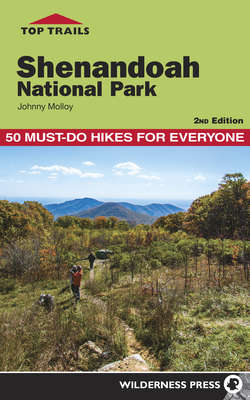Читать книгу Top Trails: Shenandoah National Park - Johnny Molloy - Страница 27
На сайте Литреса книга снята с продажи.
ОглавлениеAREA OVERVIEW
North District
The North District encompasses the most northerly of Shenandoah’s three ranger districts that divide the park. This section stretches from Front Royal, the northernmost boundary of Shenandoah, to Thornton Gap in the south, where US 211 bisects the park east–west while connecting Luray to Sperryville. Traveling south from Front Royal, the Blue Ridge rises with proverbial Skyline Drive winding atop it. Dickey Ridge Visitor Center is often a hiker’s first stop. A popular walk starts here. South of Dickey Ridge, notable heights (Compton Peak among others) begin rising where you can see the Blue Ridge rising from adjacent lowlands.
The park widens near Mount Marshall, and then you reach Mathews Arm Campground. Here, several streams and ridges spill off both sides of the Blue Ridge, creating a large wildland. On the west side of the Blue Ridge you find Overall Run Falls—the park’s highest at 93 feet—tumbling over a ragged cliff. Remote Knob Mountain and Neighbor Mountain border ultrascenic Jeremys Run, with its big pools, waterfalls, swimming holes, and everywhere-you-look beauty. The Big Devils Stairs and Little Devils Stairs are boulder-covered, rugged gorges passable only by hikers. The Piney River cuts a secluded swath between Pignut Mountain and Piney Ridge, while the North Fork Thornton River Valley recalls pioneer history with its numerous homesites. Area streams have mostly trout, but some smallmouth bass. Sycamore, white pines, and mountain laurel, along with alder thickets, border the waterways. Shenandoah’s famous oak stands rise on drier ridges. Elevations range from 550 feet near Front Royal to almost 3,400 feet atop Mount Marshall in this, the smallest of the park’s three districts.
The Appalachian Trail (AT) acts a spinal pathway for the North District, connecting all major watersheds, the mountains that divide them, and the trails that course through points high and low. The AT is useful for planning loop hikes in the North District. Most hikes here are accessed from Skyline Drive.
Visitors have one overnight option in the North District—Mathews Arm Campground. You can camp here on a first-come, first-served basis, but reservations are available on one loop. The higher elevation keeps it a good 10 degrees cooler than the Shenandoah Valley below. Make sure to store your food carefully, as Mathews Arm is bear country. More civilized accommodations can be had in nearby Front Royal or Luray.
The hikes described are either loops or out-and-back treks. Along the way you can see local highlights—Little Devils Stairs, Piney River Falls, and the old farms on Dickey Ridge. Other treks travel lesser-trod trails, such as Sugarloaf and Beecher Ridge, where park beauty is more subtle.
Permits
Permits are not required for day hiking. Backpackers must get a permit to stay in the backcountry. Simple self-registration stations are located at the Front Royal Entrance Station, the Dickey Ridge Visitor Center, the north boundary where the AT leaves the park, the Panorama, and the Thornton Gap Entrance Station.
Turk’s cap lily graces the late-summer forest on the Big Devils Stairs Trail (Trail 3).
Maps
For the North District, here are the relevant U.S. Geological Survey 7.5-minute (1:24,000-scale) topographic quadrangles, listed in geographic order as you hike along your route:
Trail 1: Chester Gap and Front Royal
Trail 2: Chester Gap
Trail 3: Chester Gap
Trail 4: Bentonville and Thornton Gap
Trail 5: Bentonville
Trail 6: Thornton Gap and Bentonville
Trail 7: Bentonville
Trail 8: Bentonville
Trail 9: Bentonville and Thornton Gap
Trail 10: Thornton Gap
Trail 11: Thornton Gap and Bentonville
Trail 12: Thornton Gap
Trail 13: Thornton Gap
